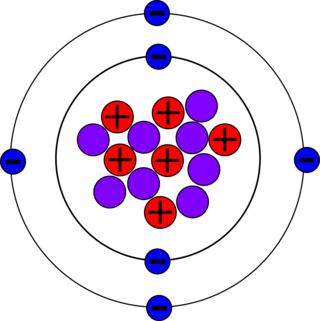Related Research Articles

Nitrogen is the chemical element with the symbol N and atomic number 7. Nitrogen is a nonmetal and the lightest member of group 15 of the periodic table, often called the pnictogens. It is a common element in the universe, estimated at seventh in total abundance in the Milky Way and the Solar System. At standard temperature and pressure, two atoms of the element bond to form N2, a colorless and odorless diatomic gas. N2 forms about 78% of Earth's atmosphere, making it the most abundant uncombined element in air. Because of the volatility of nitrogen compounds, nitrogen is relatively rare in the solid parts of the Earth.

The nitrogen cycle is the biogeochemical cycle by which nitrogen is converted into multiple chemical forms as it circulates among atmospheric, terrestrial, and marine ecosystems. The conversion of nitrogen can be carried out through both biological and physical processes. Important processes in the nitrogen cycle include fixation, ammonification, nitrification, and denitrification. The majority of Earth's atmosphere (78%) is atmospheric nitrogen, making it the largest source of nitrogen. However, atmospheric nitrogen has limited availability for biological use, leading to a scarcity of usable nitrogen in many types of ecosystems.

Carbon-14, C-14, 14
C or radiocarbon, is a radioactive isotope of carbon with an atomic nucleus containing 6 protons and 8 neutrons. Its presence in organic materials is the basis of the radiocarbon dating method pioneered by Willard Libby and colleagues (1949) to date archaeological, geological and hydrogeological samples. Carbon-14 was discovered on February 27, 1940, by Martin Kamen and Sam Ruben at the University of California Radiation Laboratory in Berkeley, California. Its existence had been suggested by Franz Kurie in 1934.

Peroxyacetyl nitrate is a peroxyacyl nitrate. It is a secondary pollutant present in photochemical smog. It is thermally unstable and decomposes into peroxyethanoyl radicals and nitrogen dioxide gas. It is a lachrymatory substance, meaning that it irritates the lungs and eyes.
Mass-independent isotope fractionation or Non-mass-dependent fractionation (NMD), refers to any chemical or physical process that acts to separate isotopes, where the amount of separation does not scale in proportion with the difference in the masses of the isotopes. Most isotopic fractionations are caused by the effects of the mass of an isotope on atomic or molecular velocities, diffusivities or bond strengths. Mass-independent fractionation processes are less common, occurring mainly in photochemical and spin-forbidden reactions. Observation of mass-independently fractionated materials can therefore be used to trace these types of reactions in nature and in laboratory experiments.
In atmospheric chemistry, NOx is shorthand for nitric oxide and nitrogen dioxide, the nitrogen oxides that are most relevant for air pollution. These gases contribute to the formation of smog and acid rain, as well as affecting tropospheric ozone.

The European Geosciences Union (EGU) is a non-profit international union in the fields of Earth, planetary, and space sciences whose vision is to "realise a sustainable and just future for humanity and for the planet." The organisation has headquarters in Munich (Germany). Membership is open to individuals who are professionally engaged in or associated with these fields and related studies, including students and retired seniors.

The atmosphere of Mars is the layer of gases surrounding Mars. It is primarily composed of carbon dioxide (95%), molecular nitrogen (2.8%), and argon (2%). It also contains trace levels of water vapor, oxygen, carbon monoxide, hydrogen, and noble gases. The atmosphere of Mars is much thinner than Earth's. The average surface pressure is only about 610 pascals (0.088 psi) which is less than 1% of the Earth's value. The currently thin Martian atmosphere prohibits the existence of liquid water on the surface of Mars, but many studies suggest that the Martian atmosphere was much thicker in the past. The higher density during spring and fall is reduced by 25% during the winter when carbon dioxide partly freezes at the pole caps. The highest atmospheric density on Mars is equal to the density found 35 km (22 mi) above the Earth's surface and is ≈0.020 kg/m3. The atmosphere of Mars has been losing mass to space since the planet's core slowed down, and the leakage of gases still continues today. The atmosphere of Mars is colder than Earth's. Owing to the larger distance from the Sun, Mars receives less solar energy and has a lower effective temperature, which is about 210 K. The average surface emission temperature of Mars is just 215 K, which is comparable to inland Antarctica. Although Mars' atmosphere consists primarily of carbon dioxide, the greenhouse effect in the Martian atmosphere is much weaker than Earth's: 5 °C (9.0 °F) on Mars, versus 33 °C (59 °F) on Earth. This is because the total atmosphere is so thin that the partial pressure of carbon dioxide is very weak, leading to less warming. The daily range of temperature in the lower atmosphere is huge due to the low thermal inertia; it can range from −75 °C (−103 °F) to near 0 °C (32 °F) near the surface in some regions. The temperature of the upper part of the Martian atmosphere is also significantly lower than Earth's because of the absence of stratospheric ozone and the radiative cooling effect of carbon dioxide at higher altitudes.
The Dole effect, named after Malcolm Dole, describes an inequality in the ratio of the heavy isotope 18O to the lighter 16O, measured in the atmosphere and seawater. This ratio is usually denoted δ18O.
Aradhna Tripati is an American geoscientist, climate scientist, and advocate for diversity. She is a professor at the University of California, Los Angeles (UCLA) where she is part of the Institute of the Environment and Sustainability, the Department of Earth, Planetary, and Space Sciences, the Department of Atmospheric and Oceanic Sciences, and the California Nanosystems Institute. She is also the director of the Center for Diverse Leadership in Science. Her research includes advancing new chemical tracers for the study of environmental processes and studying the history of climate change and Earth systems. She is recognized for her research on climate change and clumped isotope geochemistry. She studies the evolution of atmospheric carbon dioxide levels and the impacts on temperature, the water cycle, glaciers and ice sheets, and ocean acidity.

Asmeret Asefaw Berhe is a soil biogeochemist and political ecologist who is the current Director of the Office of Science at the US Department of Energy. She was previously the Professor of Soil Biogeochemistry and the Ted and Jan Falasco Chair in Earth Sciences and Geology in the Department of Life and Environmental Sciences; University of California, Merced. Her research group worked to understand how soil helps regulate the earth's climate.
Caroline Masiello is a biogeochemist who develops tools to better understand the cycling and fate of globally relevant elemental cycles. She is a professor at Rice University in the Department of Earth, Environmental and Planetary Sciences and holds joint appointments in the Chemistry and Biochemistry Departments. Masiello was elected as a Fellow of the Geological Society of America in 2017. She currently leads an interdisciplinary team of scientists who are developing microbial sensors for earth system science.
Kimberly A. Prather is an American atmospheric chemist. She is a distinguished chair in atmospheric chemistry and a distinguished professor at the Scripps Institution of Oceanography and department of chemistry and biochemistry at UC San Diego. Her work focuses on how humans are influencing the atmosphere and climate. In 2019, she was elected a member of the National Academy of Engineering for technologies that transformed understanding of aerosols and their impacts on air quality, climate, and human health. In 2020, she was elected as a member of the National Academy of Sciences. She is also an elected Fellow of the American Philosophical Society, American Geophysical Union, the American Association for the Advancement of Science, American Philosophical Society, and the American Academy of Arts and Sciences.
Arlene M. Fiore is an atmospheric chemist whose research focuses on issues surrounding air quality and climate change.
Allison Steiner is a scientist who specializes in atmosphere-biosphere interactions, regional climate modeling, and chemistry climate interactions. Steiner has received countless awards for her contributions to the field, and was invited by the National Research Council and National Science Foundation to serve on a National Academies of Sciences, Engineering, and Medicine panel. She has also contributed to the geoscience community by founding the Earth Science Women’s Network, a non-profit organization that works to further the geosciences while also supporting and connecting women in the field.
Kristie Ann Boering is a Professor of Earth and Planetary Science and the Lieselotte and David Templeton Professor of Chemistry at University of California, Berkeley. She studies atmospheric chemistry and mass transport in the extraterrestrial atmosphere using kinetics and photochemistry. Boering was elected a member of the National Academy of Sciences in 2018.
Bess Ward is an American oceanographer, biogeochemist, microbiologist, and William J. Sinclair Professor of Geosciences at Princeton University.
Emily V. Fischer is an atmospheric chemist and an associate professor in the department of atmospheric science at Colorado State University. She earned notoriety from her work on the WE-CAN project and on PAN, specifically its role in changing the distribution of oxidants in the troposphere. She has received many honors including the prestigious James B. Macelwane Medal which is "given annually to three to five early career scientists in recognition of their significant contributions to Earth and space science." Fischer is also a role model and activist in galvanizing support for women in STEM fields.
Jennifer G. Murphy is a Canadian environmental chemist and an associate professor at the University of Toronto. She is known for her research how air pollutants such as increased reactive nitrogen affect the global climate.
Patricia K. Quinn is a atmospheric chemist working at the National Oceanic and Atmospheric Agency's Pacific Marine Environmental Lab. She is known for her work on the impact of atmospheric aerosol particles on air quality and climate.
References
- 1 2 3 "Meredith Hastings, PhD – Associate Professor of Earth, Environmental and Planetary Sciences, Brown University". OnlineEducation.com. Retrieved 2019-09-13.
- ↑ Hastings, Meredith & Galanter, Meredith. (2019). Studies of reactive nitrogen in the atmosphere using global modeling and stable isotope measurements.
- ↑ "Leadership Board – ESWN" . Retrieved 2019-09-13.
- ↑ "Group members – The Alexander Group | Atmospheric Sciences | University of Washington" . Retrieved 2019-09-13.
- ↑ "Meredith Hastings | Chemistry | Brown University". www.brown.edu. Retrieved 2019-09-13.
- ↑ Anal. Chem. 200274194905-4912 Publication Date:September 7, 2002
- 1 2 G Hastings, JC Jarvis, EJ Steig (2009) Anthropogenic impacts on nitrogen isotopes of ice-core nitrate. Science, 324 (5932), 1288-1288
- 1 2 KL Casciotti, DM Sigman, MG Hastings, JK Böhlke, A Hilker (2002) Measurement of the oxygen isotopic composition of nitrate in seawater and freshwater using the denitrifier method. Analytical Chemistry, 74 (19), 4905-4912
- 1 2 B Alexander, MG Hastings, DJ Allman, J Dachs, JA Thornton, SA Kunasek (2009) Quantifying atmospheric nitrate formation pathways based on a global model of the oxygen isotopic composition (Δ 17 O) of atmospheric nitrate. Atmospheric Chemistry and Physics, 9 (14), 5043-5056
- ↑ "Who We Are – ESWN" . Retrieved 2019-09-13.
- ↑ "Progress – Promoting Geoscience Research, Education & Success" . Retrieved 2019-09-15.
- ↑ "ADVANCEGeo Partnership". ADVANCEGeo. Retrieved 2019-09-15.
- 1 2 "Hastings Receives the 2014 Atmospheric Sciences Ascent Award". Honors Program. Retrieved 2019-09-13.
- ↑ "NSF Award Search: Award#1351932 – CAREER: Quantifying the Isotopic Signature of Nitrogen Oxides Emissions Sources". www.nsf.gov. Retrieved 2019-09-15.
- ↑ "NSF Award Search: Award#1725424 – ADVANCE Partnership: From the Classroom to the Field: Improving the Workplace in the Geosciences". www.nsf.gov. Retrieved 2019-09-13.